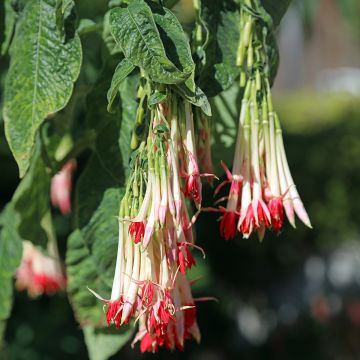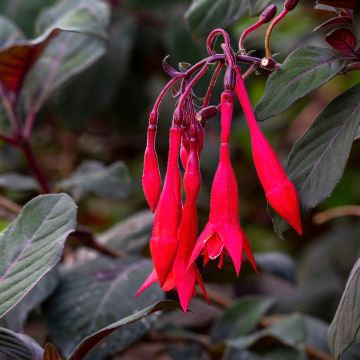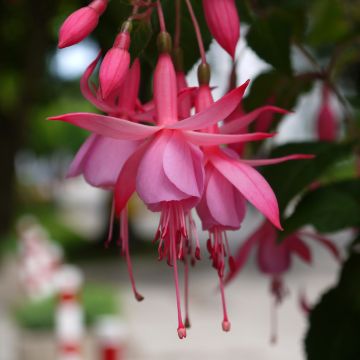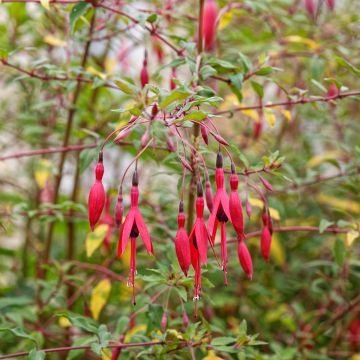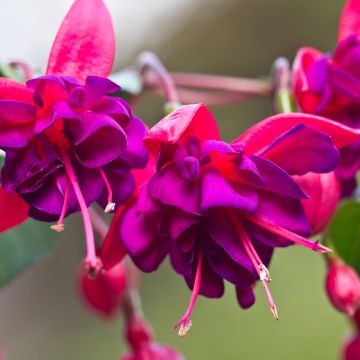

Fuchsia Ting a Ling


Fuchsia Ting a Ling
Fuchsia Ting-a-Ling
Fuchsia x hybrida Ting a Ling
Hybrid Fuchsia
Special offer!
Receive a €20 voucher for any order over €90 (excluding delivery costs, credit notes, and plastic-free options)!
1- Add your favorite plants to your cart.
2- Once you have reached €90, confirm your order (you can even choose the delivery date!).
3- As soon as your order is shipped, you will receive an email containing your voucher code, valid for 3 months (90 days).
Your voucher is unique and can only be used once, for any order with a minimum value of €20, excluding delivery costs.
Can be combined with other current offers, non-divisible and non-refundable.
Why not try an alternative variety in stock?
View all →This plant carries a 6 months recovery warranty
More information
We guarantee the quality of our plants for a full growing cycle, and will replace at our expense any plant that fails to recover under normal climatic and planting conditions.
Would this plant suit my garden?
Set up your Plantfit profile →
Description
Fuchsia 'Ting-a-Ling' is a vigorous and floriferous variety characterised by upright growth, and medium-sized, single white flowers. The plant blooms continuously from early summer to early autumn. It is a semi-hardy plant that is easy to grow in partial shade. It can be grown in a large pot, or in fertile, moist, and light soil.
There are thousands of hybrid fuchsias. For the most part, they are derived from Fuchsia magellanica and F. fulgens, with occasional contributions from F. triphylla, which adds length to the flowers, characterised by thin tubes and violet-hued undersides of the leaves. All these herbaceous to woody plants, varying in hardiness and growth habit, belong to the Onagraceae family.
Fuchsia 'Ting-a-Ling' is an excellent American cultivar dating back to 1959. The plant quickly forms a well-branched, upright bush, whose height varies depending on growing conditions. In favourable climates, it can reach up to 1.5m (5ft) in the ground, and around 70 to 80cm (28 to 32in) in a pot. Its flowering period extends from May-June to September-October. Its single flowers, hanging from a peduncle, consist of a white tube extended by 4 long, reflexed sepals that are white with green tips, and a corolla of wider, shorter petals that are also white. It bears long stamens with pink anthers. The stems are initially herbaceous, becoming somewhat woody over the season. They bear an abundance of foliage composed of slender deciduous leaves. They are opposite, whorled in groups of 3 or 5, with entire, dentate margins, measuring 3cm (1in) in length. The lanceolate leaves are a glossy green. The hardiness of the stump does not exceed -6 to -7°C (21.2 to 19.4°F) in the ground.
This superb Fuchsia 'Ting-a-Ling' performs wonders in mild, humid Atlantic coastal gardens. It can be planted in a small hedge or a large flower bed, alongside hydrangeas or lilies, for example. In regions with colder winters, it can be grown in a large pot and brought indoors for protection from frost. Fuchsias are partial shade plants that pair well with ferns, bugbanes with orange or pink foliage, and blue or light green hostas. In a mixed container, they can be planted with dwarf ivies, lobelias, or Madagascar periwinkles. Fuchsia 'Ting-a-Ling' also creates a striking effect when combined with dark-coloured coleus varieties such as 'Black Prince' or FlameThrower Salsa Roja.
Discovered in Santo Domingo in the 17th century and acclimatised in Europe, it was named Fuchsia (not Fuschia) in honour of a German botanist named Fuchs. Native to South America, botanical fuchsias have gradually multiplied. There are now believed to be tens of thousands of hybrids!
Fuchsia Ting-a-Ling in pictures
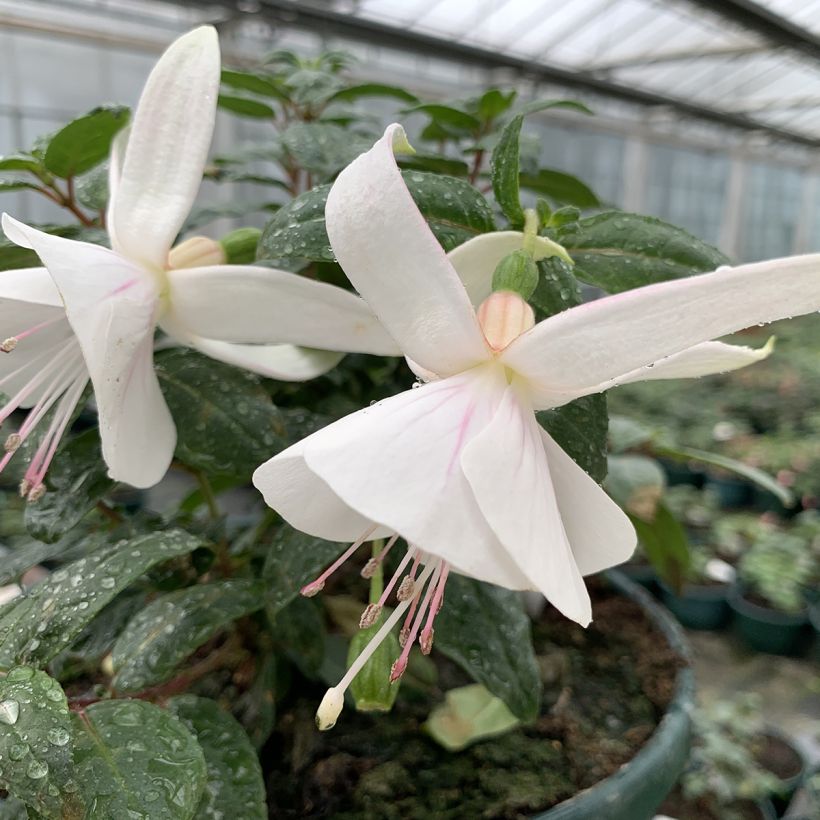

Flowering
Foliage
Plant habit
Botanical data
Fuchsia
x hybrida
Ting a Ling
Onagraceae
Hybrid Fuchsia
Cultivar or hybrid
Other Fuchsia
View all →Planting and care
Plant in rich, moist, and well-drained substrate. Place it in a location with the morning sun or partial shade. Fuchsias need plenty of light to flower well, but they are sensitive to full summer sun. They prefer a cool temperate climate and do not tolerate hot summers, even with regular watering. Water regularly, as they are sensitive to drought. However, avoid overwatering. When grown in pots, do not leave water in the saucer, as it can cause the roots to rot and the leaves to fall off. Feed with a liquid fertiliser for fuchsias every 15 days during the growth period. Regularly remove faded flowers and dry leaves. Young shoots can be pinched to encourage the plant to branch out and produce more flowers, which are always borne on the current year's shoots. Prune back in autumn after flowering. Fuchsias can also be grown indoors, where they are perennial and evergreen.
In the ground, protect the stump in winter with a thick layer of mulch.
Planting period
Intended location
Care
Planting & care advice
This item has not been reviewed yet - be the first to leave a review about it.
Similar products
Haven't found what you were looking for?
Hardiness is the lowest winter temperature a plant can endure without suffering serious damage or even dying. However, hardiness is affected by location (a sheltered area, such as a patio), protection (winter cover) and soil type (hardiness is improved by well-drained soil).

Photo Sharing Terms & Conditions
In order to encourage gardeners to interact and share their experiences, Promesse de fleurs offers various media enabling content to be uploaded onto its Site - in particular via the ‘Photo sharing’ module.
The User agrees to refrain from:
- Posting any content that is illegal, prejudicial, insulting, racist, inciteful to hatred, revisionist, contrary to public decency, that infringes on privacy or on the privacy rights of third parties, in particular the publicity rights of persons and goods, intellectual property rights, or the right to privacy.
- Submitting content on behalf of a third party;
- Impersonate the identity of a third party and/or publish any personal information about a third party;
In general, the User undertakes to refrain from any unethical behaviour.
All Content (in particular text, comments, files, images, photos, videos, creative works, etc.), which may be subject to property or intellectual property rights, image or other private rights, shall remain the property of the User, subject to the limited rights granted by the terms of the licence granted by Promesse de fleurs as stated below. Users are at liberty to publish or not to publish such Content on the Site, notably via the ‘Photo Sharing’ facility, and accept that this Content shall be made public and freely accessible, notably on the Internet.
Users further acknowledge, undertake to have ,and guarantee that they hold all necessary rights and permissions to publish such material on the Site, in particular with regard to the legislation in force pertaining to any privacy, property, intellectual property, image, or contractual rights, or rights of any other nature. By publishing such Content on the Site, Users acknowledge accepting full liability as publishers of the Content within the meaning of the law, and grant Promesse de fleurs, free of charge, an inclusive, worldwide licence for the said Content for the entire duration of its publication, including all reproduction, representation, up/downloading, displaying, performing, transmission, and storage rights.
Users also grant permission for their name to be linked to the Content and accept that this link may not always be made available.
By engaging in posting material, Users consent to their Content becoming automatically accessible on the Internet, in particular on other sites and/or blogs and/or web pages of the Promesse de fleurs site, including in particular social pages and the Promesse de fleurs catalogue.
Users may secure the removal of entrusted content free of charge by issuing a simple request via our contact form.
The flowering period indicated on our website applies to countries and regions located in USDA zone 8 (France, the United Kingdom, Ireland, the Netherlands, etc.)
It will vary according to where you live:
- In zones 9 to 10 (Italy, Spain, Greece, etc.), flowering will occur about 2 to 4 weeks earlier.
- In zones 6 to 7 (Germany, Poland, Slovenia, and lower mountainous regions), flowering will be delayed by 2 to 3 weeks.
- In zone 5 (Central Europe, Scandinavia), blooming will be delayed by 3 to 5 weeks.
In temperate climates, pruning of spring-flowering shrubs (forsythia, spireas, etc.) should be done just after flowering.
Pruning of summer-flowering shrubs (Indian Lilac, Perovskia, etc.) can be done in winter or spring.
In cold regions as well as with frost-sensitive plants, avoid pruning too early when severe frosts may still occur.
The planting period indicated on our website applies to countries and regions located in USDA zone 8 (France, United Kingdom, Ireland, Netherlands).
It will vary according to where you live:
- In Mediterranean zones (Marseille, Madrid, Milan, etc.), autumn and winter are the best planting periods.
- In continental zones (Strasbourg, Munich, Vienna, etc.), delay planting by 2 to 3 weeks in spring and bring it forward by 2 to 4 weeks in autumn.
- In mountainous regions (the Alps, Pyrenees, Carpathians, etc.), it is best to plant in late spring (May-June) or late summer (August-September).
The harvesting period indicated on our website applies to countries and regions in USDA zone 8 (France, England, Ireland, the Netherlands).
In colder areas (Scandinavia, Poland, Austria...) fruit and vegetable harvests are likely to be delayed by 3-4 weeks.
In warmer areas (Italy, Spain, Greece, etc.), harvesting will probably take place earlier, depending on weather conditions.
The sowing periods indicated on our website apply to countries and regions within USDA Zone 8 (France, UK, Ireland, Netherlands).
In colder areas (Scandinavia, Poland, Austria...), delay any outdoor sowing by 3-4 weeks, or sow under glass.
In warmer climes (Italy, Spain, Greece, etc.), bring outdoor sowing forward by a few weeks.






























